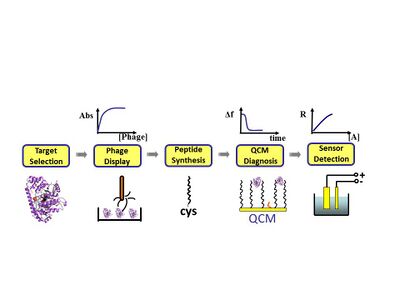Banta:Sensors

Banta Lab
Protein and Metabolic Engineering
| Home | Lab Members | Publications | Research Interests | Courses | Pictures | Positions Available |

Engineering Biosensors
Biosensors are created by coupling biomolecular recognition with an electrochemical process to detect the presence of target analytes. The biomolecular recognition can be a simple binding event or it can be a more complex catalytic process. We are interested in developing new biosensors for a variety of applications. Not only are we interested in developing functional systems but we are also interested in developing platforms for creating new biosensors rapidly for the detection of emerging targets. We are aiming to develop new design rules for predicting biosensor performance prior to device construction.
In one approach, we have been using phage display to identify short unstructured peptides that bind to different protein targets. So far, we have used phage display to identify peptides that can bind to Troponin I which is a cardiac cell stress marker and ALT which is a liver cell stress marker. These peptides bind the targets with high affinity and we have been able to immobilize these peptides on gold electrodes. We have used a variety of analytical techniques in order to develop the optimal electrochemical techniques to make biosensors from the peptides and we have determined that electrochemical impedance spectroscopy (EIS) is an ideal platform for detecting the target proteins using the peptide-based biosensors.
We have also developed biosensors for the superoxide radical, organophosphate compounds, and formaldehyde. We have also “wired” glucose oxidase with gold nanoparticles, which may be a useful approach for creating glucose biosensors. Currently we are working on engineering a globular protein to bind explosives molecules and we are working on a new Vitamin D biosensor.
Related Publications
- Chandra D, Sankalia N, Arcibal I, Banta S, Cropek D, and Karande P. Design of affinity peptides from natural protein ligands: A study of the cardiac troponin complex. Biopolymers. 2014 Jan;102(1):97-106. DOI:10.1002/bip.22436 |
- Holland JT, Lau C, Brozik S, Atanassov P, and Banta S. Engineering of glucose oxidase for direct electron transfer via site-specific gold nanoparticle conjugation. J Am Chem Soc. 2011 Dec 7;133(48):19262-5. DOI:10.1021/ja2071237 |
- Wu J, Park JP, Dooley K, Cropek DM, West AC, and Banta S. Rapid development of new protein biosensors utilizing peptides obtained via phage display. PLoS One. 2011;6(10):e24948. DOI:10.1371/journal.pone.0024948 |
- Wu J, Cropek DM, West AC, and Banta S. Development of a troponin I biosensor using a peptide obtained through phage display. Anal Chem. 2010 Oct 1;82(19):8235-43. DOI:10.1021/ac101657h |
- Lu HD, Wheeldon IR, and Banta S. Catalytic biomaterials: engineering organophosphate hydrolase to form self-assembling enzymatic hydrogels. Protein Eng Des Sel. 2010 Jul;23(7):559-66. DOI:10.1093/protein/gzq026 |
- Park JP, Cropek DM, and Banta S. High affinity peptides for the recognition of the heart disease biomarker troponin I identified using phage display. Biotechnol Bioeng. 2010 Mar 1;105(4):678-86. DOI:10.1002/bit.22597 |
- Chen XJ, West AC, Cropek DM, and Banta S. Detection of the superoxide radical anion using various alkanethiol monolayers and immobilized cytochrome c. Anal Chem. 2008 Dec 15;80(24):9622-9. DOI:10.1021/ac800796b |